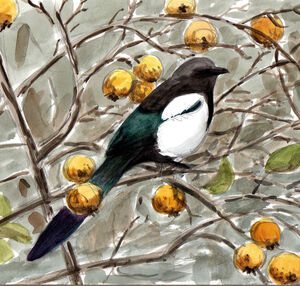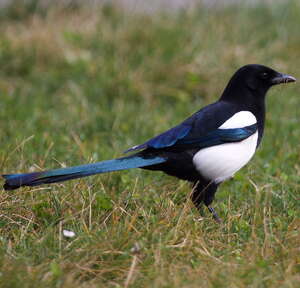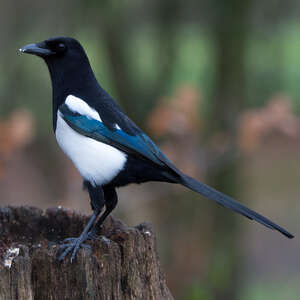Eurasian Magpie
Pica pica - Pie bavarde
Identification
No need to describe the Eurasian Magpie which is immediately recognisable by its silhouette and plumage. All one has to do is look at the photos to the right. Everyone can immediately identify this long-tailed bird. Its name even refers to black and white animals, such as a piebald horse. So there is no need for an elaborate description - images alone are enough. Note the characteristic 'corvid' features - great size, robust beak and feet. The sexes are alike. In good light, the adult's black plumage shows blue, indigo, violet and green-bronze tints to stunning effect. The juvenile has a shorter tail, black plumage like soot with muted tints, and white feathers tinged slightly with russet, with a pale eyering making the eye stand out. Currently, six subspecies are recognised, differing slightly in size and the relative proportions of white and black in the plumage, mainly in the primaries and rump. Previously, there were more, but four have been raised to the status of full species.
Subspecific information 6 subspecies
- Pica pica pica (British Isles and s Scandinavia to e Europe and Asia Minor)
- Pica pica fennorum (n Scandinavia and nw Russia)
- Pica pica melanotos (Iberian Pen.)
- Pica pica bactriana (c Russia to Iran, n India and Mongolia and w, s Siberia)
- Pica pica leucoptera (se Russia and ne China)
- Pica pica camtschatica (Kamchatka Pen.. ne Siberia.)
Foreign names
- Pie bavarde,
- Urraca común,
- pega-rabilonga,
- Elster,
- szarka,
- Ekster,
- Gazza,
- skata,
- Skjære,
- straka obyčajná,
- straka obecná,
- Husskade,
- harakka,
- garsa,
- Skjór,
- sroka (zwyczajna),
- žagata,
- sraka,
- Сорока,
- ユーラシアカササギ,
- 欧亚喜鹊,
- นกสาลิกาปากดำ,
- 喜鵲,
Voice song and call
It is said that Magpies jabber and, with what this word evokes in our minds, this is justified. The Eurasian Magpie is indeed very talkative. The most common cry is a harsh, isolated kiak or a doubled ka-yak or "tcha-iak". But the cry we are used to hearing and noticing because it is the loudest is a rapid succession of 4 to 8 dry notes tcha cha cha cha cha chak. It is uttered on all occasions and more often than we would like. It is probably this cry that earned it the nickname of agasse or jabbering. When it is anxious, it utters the same cry but the phrase lengthens and the tone hardens. Otherwise, there are proximity and contact cries that birds exchange, for example in the intimacy of the couple, short cries, often harsh and grating, for example reeeh or krah.
Habitat
The Eurasian Magpie occupies all open and semi-open terrestrial habitats. The condition of its presence is that there are at least some woody plants for nesting.
Behaviour character trait
The Eurasian Magpie is easy to observe, for example when it strides across a lawn or garden with a bouncy gait. Its body motions are quite comical. When it wants to go faster, it can hop on both legs at once. It can also be seen probing the ground for prey with its beak as it is essentially a predator. Vegetable gardens do not risk much from it, and in fact it helps keep potential vermin populations in check. On the other hand, its nest robbing of small passerines can be feared, as it has no problem spotting their nests. This may be why it is classified as a pest in France and can be hunted as game. However, the Eurasian Magpie is just playing the role that nature has assigned it. It has natural enemies to limit its population, such as the Accipiters, or hawks and sparrowhawks. In Mediterranean regions, its nests may be parasitized by the cuckoo. As seen before, the Eurasian Magpie feels quite at home in cities. Overall, it frequents areas around human activities. It is both brave and very wary. It may approach dwellings closely but remain very suspicious and always on guard. Any wrong move and it is off in a hurry. In this it resembles other corvids, like the crow, which is known for its high level of intelligence.
Taking to the air, it loses a bit of its fear, which may explain why it may nest high up in a tree in a garden, park, or playground, which are still regularly frequented. It is possible that the urban Magpie is less fearful than the rural Magpie. The Eurasian Magpie is accused of being a thief, of stealing showy objects and hiding them.I think this is probably just a legend, a misinterpretation of certain observations. After all, magpies, like all corvids, hide food so that they have something to eat in times of need. One day someone might have seen a magpie hiding something, leading them to the conclusion that it must have been the object they had just lost. Thus, the legend was born. Géroudet believes that the magpie might be attracted towards unusual objects in its environment, claim it as its own, and hide it like they would with prey, or even bring it back to its nest, as suggested by a comic book from my childhood. That might be possible. Domesticated magpies have a distinct interest for shiny objects, specifically the eyes of their masters, and make attempts to reach them when they are on their shoulders. However, it is illegal to keep these birds as pets in France, so one should be careful, or at least used to be. Outside of the breeding season, Eurasian Magpies become somewhat gregarious. Family groups can persist for a while and aggregate together, forming loose flocks of immature or unemployed birds that roam around, each keeping an eye on the rest whilst they search for food. They gather together to preen and rest, and spend the night in a dormitory, all of this being done out of protection from predators.In these groups one can identify couples by their behavior. At the end of winter, individuals become more agitated and show signs of nervousness, giving rise to discussions, acrobatics in trees and chases accompanied by cries. All of this preludes the pairing of the previous year's young who will not take long to leave the group to search for a new territory. The already established couples meanwhile will return to their territory.Flight
With its short, rounded wings, the Eurasian Magpie isn't built for speed records. It has a direct, albeit slow, flight, with rapid, jerky wingbeats that create an illusion of irregularity and sudden changes in rhythm.
It's quite odd - is it just an effect, or is it the bird's reality? At any rate, its flight is unique and typical. Its limited flying capabilities mean it always travels at low altitudes, never high in the sky where it would be vulnerable. When it soars in open spaces, it does so with haste rather than grace, aiming to quickly reach the nearest trees and shrubs, where it is more at ease.Dietfeeding habits
The Eurasian Magpie feeds almost exclusively on the ground. It can be classified as omnivorous, but it is primarily a predator.
Its diet is decidedly insectivorous during the warmer months, but there is still a significant amount of small vertebrates. Amongst the invertebrates, the Coleoptera are always well represented, followed by Lepidoptera and other terrestrial taxa such as annelids. When it comes to vertebrates, its main prey are lizards, emerging amphibians, eggs and chicks of passerines, and young micro-mammals. It also consumes seeds and small fruit in small amounts and depending on the season. It follows the work of farmers and gardeners, which can potentially kill animals or bring out prey from the ground. Like the Carrion Crow, it is not opposed to scavenging. It can take advantage of animals killed on the road, including insects. It is also a regular visitor at dumps and other centers of disposal,which offer edible matter, picnic areas, public parks and tourist centers, where it can get leftovers from meals. It regularly stores food in case of shortage.Reproduction nesting
The breeding season begins early due to the species' sedentary lifestyle and the permanent pairing of mates. A few displays at the end of the winter are enough to solidify the couple and nesting can begin. Nest building is a labour-intensive operation that requires the couple to work for long weeks, up to 5-6. This monumental nest, despite its relatively permanent nature, is only used once for reproduction. Usually, the couple builds a new nest every year. The nest is usually built in the upper part of a young tree, at the terminal fork of the trunk for a leafy tree, at the level of one of the last verticillos for a conifer, usually at a height of 10 metres.
It is often an Italian poplar that is chosen because its morphology suits it well. When there is no choice, the couple may opt for a shrub or even a bush, especially if the site is protected by prickly thorns or dense thickets. The platform of the nest is typically corvid. It is a structure of dried twigs and sticks collected from the ground and held together by mud. The deep cut is carefully lined with roots. Finally, a protective dome, often made of spiny and tightly woven twigs, caps it all. The birds access the nest through a lateral opening made in the dome. The appearance of the Eurasian Magpie's nest is really typical and cannot be confused with any other nest. That of the red squirrel may look similar from afar, as it is also in a ball. But it is made of living leafy twigs, which give it a very different look up close. Placed high in a tree, the nest is exposed to the wind. The gusts make it swing significantly, but the flexibility of the trunk at this level allows it to hold.The female lays 4 to 9 eggs that are gray-green and speckled with brown. The female incubates them for 16 to 21 days and is fed by the male during this period. After hatching, both adults will feed the young. The male also watches over the nest and will not hesitate to chase away any curious predators. The young magpies leave the nest at 25 to 29 days old. Family groups remain together throughout the summer and in the autumn they join groups of non-nesting Eurasian Magpies.Geographic range
The Eurasian Magpie's range stretches across all of Eurasia, from the British Isles and Spain to Anadyr in the far east of Russia. All of Europe is occupied, from the Mediterranean to northern Scandinavia. In the Mediterranean, the magpie is present in Sicily but not in Corsica nor Sardinia, and in Cyprus but not in Crete. Further east, the range follows Siberia, but with an interruption north of the Sea of Okhotsk. To the south, it passes through Asia Minor (Turkey), northern Middle East, Central Asia, Pakistan, and just touches the extreme north of India. 6 subspecies share this vast domain. 4 close species, formerly assigned to Pica pica, occupy the peripheral zones: P. mauritanica in North Africa, P. asirensis in the Arabian Peninsula, P. bottanensis in Bhutan and western China, and P. serica in Russian Ussuriland, both Koreas, a large part of eastern China including Taiwan, and finally in northern Myanmar and Indochina.
Threats - protection
IUCN conservation status
concern
in the Wild
threatened
evaluated
The Eurasian Magpie is a common to very common species throughout most of its range. It is not threatened. In fact, it is locally on the rise. It is categorized as Least Concern by global organizations. Its problem is that it has a bad reputation in France, for no scientifically proven reason, and is therefore labeled as nuisance and can be shot without restriction. Despite this, its populations are in good health, as it is clever and therefore not easy to shoot. It is also possible that mindsets change, even in the hunting world, that the concept of nuisance evolves in people's minds and behaviours evolve in a positive direction. Its proximity to humans has favourably aided its success. In urban areas, it is better protected from predators. In rural areas, cultivated areas provide it with food opportunities.
Sources of information
- IOC World Bird List (v15.1), Gill, F and D Donsker (Eds). 2025-12-07.
- Les passereaux d'Europe, tome 1, P. Géroudet, M. Cuisin
- Avibase, Lepage Denis
- HBW Alive,
- xeno-canto, Sharing bird sounds from around the world,
Other sources of interest
 Specification sheet created on
11/07/2023 by Jean François
Specification sheet created on
11/07/2023 by Jean FrançoisTranslation by AI Oiseaux.net
© 1996-2026 Oiseaux.net
- Accipitriformes
- Aegotheliformes
- Anseriformes
- Apodiformes
- Apterygiformes
- Bucerotiformes
- Caprimulgiformes
- Cariamiformes
- Casuariiformes
- Charadriiformes
- Ciconiiformes
- Coliiformes
- Columbiformes
- Coraciiformes
- Cuculiformes
- Eurypygiformes
- Falconiformes
- Galliformes
- Gaviiformes
- Gruiformes
- Leptosomiformes
- Mesitornithiformes
- Musophagiformes
- Nyctibiiformes
- Opisthocomiformes
- Otidiformes
- Passeriformes
- Pelecaniformes
- Phaethontiformes
- Phoenicopteriformes
- Piciformes
- Podargiformes
- Podicipediformes
- Procellariiformes
- Psittaciformes
- Pterocliformes
- Rheiformes
- Sphenisciformes
- Steatornithiformes
- Strigiformes
- Struthioniformes
- Suliformes
- Tinamiformes
- Trogoniformes



































